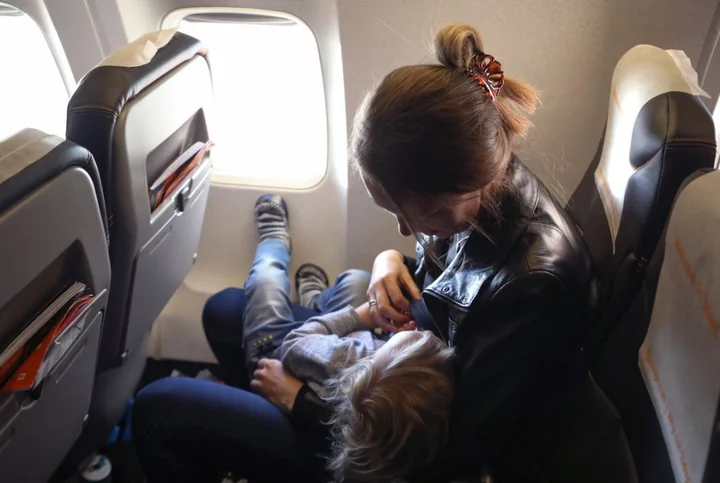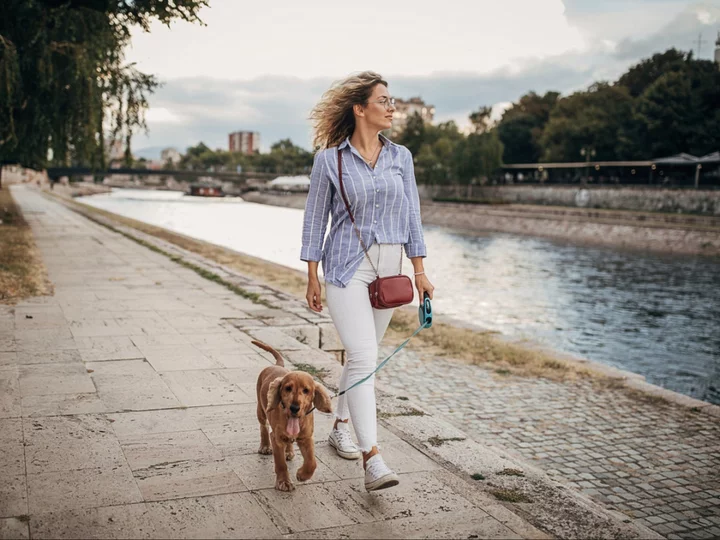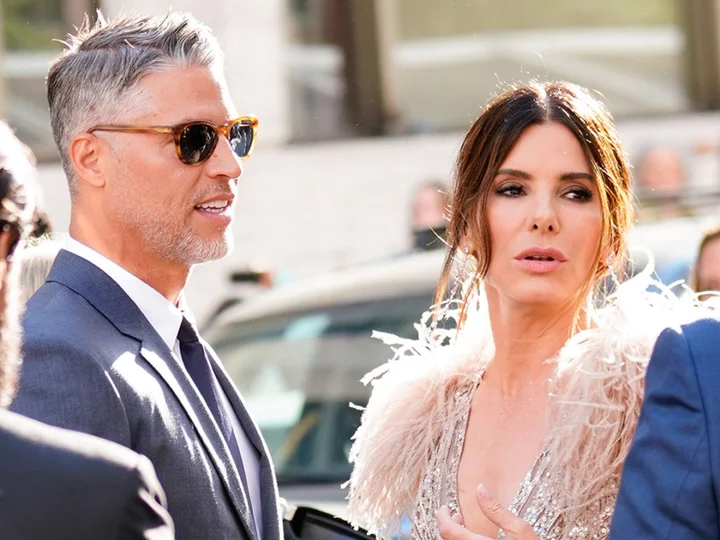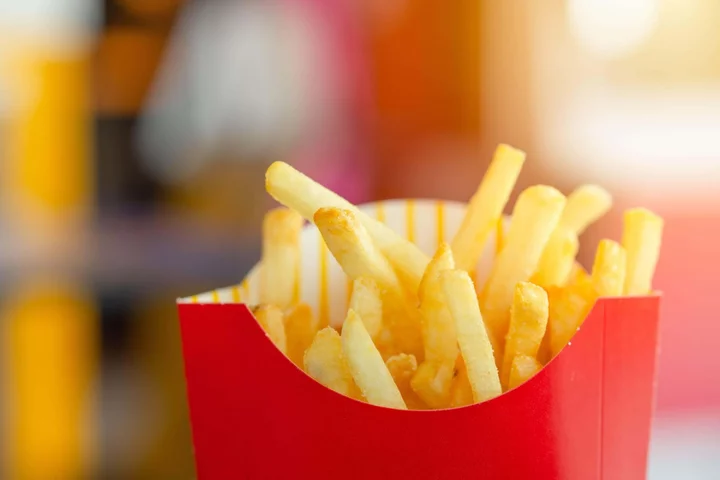
Woman says she was told not to breastfeed on flight because it would make passengers ‘uncomfortable’
People are coming to a woman’s defence after she claimed that she was told not to breastfeed on a plane because it would make other travellers “uncomfortable”. Chelsea Williams took to Facebook on 7 August to describe what she says was her experience with TUI Airways, a British airline owned by the TUI Group. She claimed that while she was in her seat during a recent flight and breastfeeding her child, one of the plane’s crew members told her to stop. “During our outbound flight I was told I was not allowed to breastfeed (even though we were both buckled) during takeoff and landing,” she wrote. “I have never had this with other airlines, in fact, it is encouraged to help with baby ear pain!” She then claimed that, after the experience, she was encouraged to reach out to TUI about its travelling regulations. “Before my inbound flight, I thought I’d check what the official rules were as I was shocked it wasn’t allowed as it left my baby screaming as a consequence,” she wrote. William’s post went on to include the message that her husband, Thomas, sent to TUI, asking if his partner could breastfeed their five-week-old baby while their plane is taking off and landing. According to the screenshot of the message, TUI then responded by encouraging Thomas’ wife to avoid breastfeeding on the plane, for the sake of other passengers. “There are no official restrictions, however, we would not recommend it because it could make other people uncomfortable,” the message read. Williams also added that the response from TUI was “complete discrimination and majorly disappointing”. Speaking to The Independent, Williams said that while on her first flight with TUI, the airline employee tried to “disguise the airline’s discrimination with the guise of a ‘safety issue’ but later retracted that”. “The cabin crew member said: ‘You’ll need to stop feeding as it is not permitted on takeoff and landing,’” she explained. “She then said my five-week old had to forward face, I said that she doesn’t have sufficient neck support at that age, which was answered with: ‘Maybe you could just sit her against you facing forward and lean back a bit.’” She also specified that, despite what TUI had allegedly told her husband in its message, she was able to breastfeed her daughter on her flight back home. Her Facebook post has since gone viral, with more than 1,200 reactions. In the comments, many people have gone on to defend Williams while criticising TUI for its “damaging” message about mothers breastfeeding in public. “Oh TUI - it’s damaging comments like this that can deter women from breastfeeding or breastfeeding in public,” one person wrote. “What’s so offensive about feeding a baby and if people are uncomfortable about a baby feeding in the most natural way by milk that is designed for HUMANS then that is their issue not hers or her baby’s fault.” “If other people are allowed to eat and drink in public then why is breastfeeding our children not allowed. What a disgusting response!!!” another added. “To all the breastfeeding moms out there, keep going. We’ve got this. Screw what other people say and think. Just smile at them and carry on, that will make them uncomfortable!” “This is absolutely disgraceful!!” a third wrote. “I am flying with TUI next month and have every intention of breastfeeding during take off and landing whether anyone feels ‘uncomfortable’ or not!” TUI has since responded to the comments on Williams’ post, with the company stating that it is “aware of the situation and are conducting an internal investigation”. TUI also added that “breastfeeding is permitted” on its flights, while the company “advises against it during takeoff and landing for safety reasons”. According to the Centers for Disease Control and Prevention, mothers are encouraged to breastfeed their children “during takeoff and landing when travelling by airplane,” as “this will help to protect your child from ear pain due to cabin pressure changes”. The health agency also encourages mothers to feed their children “on demand,” noting that the best way for them to “maintain [their] milk supply is to breastfeed whenever [their] baby is hungry”. Speaking to Metro, Williams opened up about the breastfeeding incident during her first TUI Airways flight, which was from England to Spain. She said that after she stopped breastfeeding, after the airline employee had asked her to do so, her “baby was obviously crying”. “Quite drastically because I had cut her feed while she was in the middle of it - and the toddler was crying,” she added, referring to her two-year-old child. “I was sweating, I was on the verge of tears. I felt like everyone’s eyes were on us because obviously the baby was screaming and I obviously looked not great at that moment. The baby’s cries were getting worse – she was obviously in pain, she was obviously hungry as well.” Williams said that she waited until the seatbelt lights went off to start feeding her baby again. In a statement toThe Independent, TUI said: “We are really sorry for the distress caused to Ms Williams and her infant. As a family friendly travel company we support breastfeeding on our flights at any time. We will be making sure that all colleagues are retrained on our breastfeeding friendly policy.” Williams told The Independent that she “had a call with TUI” and talked to the company about some of the changes she hopes to see implemented. “They did sound receptive to some of the points raised, I will continue to push them to ensure these changes are made,” she said. Read More Breastfeeding Olympians want it all: Top careers and motherhood Ireland Baldwin reveals why she did not want to breastfeed her daughter after giving birth Couple flies abroad for day trip after they find flights are cheaper than train to London Americans spark backlash after claiming that Europeans ‘don’t believe in water’ Grimes says her and Elon Musk’s three-year-old child X ‘knows a lot about rockets’ What is TikTok’s ‘soft life era’ and could it be the secret to happiness?
2023-08-10 06:53

Grimes says her and Elon Musk’s three-year-old child X ‘knows a lot about rockets’
Grimes has opened up about raising her children with ex, Elon Musk, with the musician revealing that their three-year-old son “knows a lot about rockets”. The singer, 35, spoke candidly about co-parenting with the Tesla CEO during her cover story interview with Wired, published on 8 August. Along with their three-year-old, X Æ A-12 - who goes by “X” - the former couple shares a one-year-old daughter, Exa Dark Sideræl, who goes by “Y”. While speaking to Wired, Grimes was asked about Musk’s “weird kind of protégé thing going on” with their son, as he’s taken him to “meetings” and work events before. However, Grimes said that she’s “here for that” relationship between the father and son, before explaining that they share common interests. “X knows a lot about rockets,” she said. “It’s crazy. He knows more about rockets than me.” She then specified that she and Musk have stopped giving X toys, since he “gets upset” if “they’re not anatomically correct”. However, the singer confessed that she’s been a little worried about her son’s interest in space, as she described his reaction to the Starship rocket exploding earlier this year. “He’s a little engineer, for sure. But his obsession with space is bordering on: ‘Is this healthy?’ When X saw Starship blow up, he had, like, a three-day PTSD meltdown,” Grimes recalled. “Every hour, he was waking up and going: ‘Starship …’ and I had to rub his back.” Grimes - who announced her split from Musk in 2022- shared that her daughter is “a little engineer too,” explaining: “She likes industrial shipping. She’s very strange.” As she continued to open up about co-parenting with her ex, she said that she’s “trying to find a great peer group,” or “other parents who are sort of like us and share similar values”. She went on to speak candidly about the different boundaries she wants to set as a parent. “I really care about having a very good relationship with my kids. I think I understand how to be a good parent to them,” she said. “Both enforcing discipline and being their friend. Who knows, maybe they’ll resent me and reject family culture, but I feel like they will not.” She also confessed that she’s “a little bit” worried about her children’s privilege, as their father holds the title as the richest person in the world. “I think their life is gonna be pretty intense,” she said. “Being Elon’s kid is not the same as being anyone’s kid. In my house, at least, I want it to be more of a crazy warehouse situation and a cool art space.” Grimes and Musk first met in 2018 when he direct messaged her on social media, where they then made the same pun about artificial intelligence. In September 2021, Musk revealed to Page Six that he and Grimes have “semi-separated” due to conflicting schedules and locations. Two months later, the pair welcomed their daughter together via surrogate. After the announcement made headlines, Grimes told Vanity Fair in March 2022 that she and Musk have a fluid, inexplicable partnership. However, she later made a clarification about the comment on Twitter, noting that while she and Musk had broken up since welcoming their daughter, “he’s my best friend and the love of my life”. Elsewhere in her interview with Wired, Grimes acknowledged that she’s learned a lot from her ex, specifically when it comes to leadership skills. “I learned from him, like, the best internship ever. People don’t like talking about Elon, but it was incredible to be right there watching all that SpaceX stuff happen,” she said. “That’s a master class in leadership and engineering and makes you understand how rare it is to have a leader of that quality.” Grimes continued to praise Musk’s management skills, adding: “Elon has an old-world kind of discipline I really respect. And I think it rubs a lot of people the wrong way. They don’t want to be in that hardcore zone. If you’re not consenting to being in that hardcore zone, I get it.” She also specified that Musk has “challenged” her a lot, and taught her about running her own company and team. When asked what her ex learned from her, she said that she’s helped him “have more fun”. “I try to soften him up, to build family culture,” she said. “And he steals a lot of my memes.” Read More Elon Musk gave Grimes a ‘trivia test’ on Lord of the Rings when they first started dating Grimes criticised for remarks about Lizzo accusers Grimes weighs in on alleged cage match between Elon Musk and Mark Zuckerberg Elon Musk gave Grimes a ‘trivia test’ on Lord of the Rings when they started dating Grimes weighs in on alleged cage match between Elon Musk and Mark Zuckerberg Mark Zuckerberg reveals his 4,000 calorie diet and large McDonald’s order
2023-08-10 06:28

What is TikTok’s ‘soft life era’ and could it be the secret to happiness?
The term ‘soft life’ is trending on TikTok, with the #softlifeera tag clocking 12.2million views. While not brand new, it seems a growing number of social media users are leaning towards the lifestyle concept – but what does soft life actually mean and how can it benefit people? Where does the trend come from? As the wording suggests, soft life is all about veering away from stress and struggle and embracing a more easy and enriched life. But this isn’t just about life looking ‘perfect’ on social media. “Soft life isn’t new, however I’m really grateful to see its resurgence,” said Chlöe Pierre, founder of wellness platform thy.self and author of Take Care: The Black Women’s Guide To Wellness. “Essentially to me, especially as a black woman, soft life is about making choices that can avoid me having to live a much longer, and unsustainable, life in hardship. For me it’s about wellness in general, and sustainable wellness. “My only concern when seeing trends [on social media] is that they are inclusive, and generally they aren’t. First and foremost, soft life is a choice – and it’s a privilege to be able to make that choice,” Pierre added. “Originally, the soft life kind of movement had origins in places like Nigeria and other places around the continent, but was popularised via America and a lot of African American women, [who were often] fictional characters on TV. Because there weren’t, especially not in the UK, reachable or visible representations of black women and women of colour that had amassed a wealth, and therefore the privilege of living a ‘soft life’.”Permission to live a soft life For Dr Evelyn Okpanachi, author of The Emotionally Empowered Woman, it makes sense people are increasingly leaning towards the trend. “Collectively, we are still tired. We have had the Covid era, austerity and more, and we simply want to live and breathe a little. This is why we are leaning towards it more right now. Collectively, we are breathing a sigh of relief,” said Okpanachi. “Most people associate the soft life with booking last-minute flights, mojitos on the beach, dining at nice restaurants and all of the externalities. It is in part, but it a lot deeper than that. “Soft life is living life on your terms. Creating a career you want, the business you want, and looking after yourself holistically. This starts with empowering yourself to succeed by elevating your mindset and knowing you deserve to live a soft life.” Nothing comes easy Okpanachi noted the work that can be involved, however. “In order to enter the soft life era, the average person tends to go through an element of stress. Nothing comes easy,” she explained. “It is essentially about purposely creating a lifestyle with minimal stress and setting boundaries – boundary setting is key. It’s embracing the things that serve you and letting go/eliminating the things that don’t. We all deserve to live a soft life, and we all should. But we have to put the work in to attain it.” This is something social media can often miss out. As Pierre noted, influencers or celebrities may “show you one side of their life – you don’t get to see the struggle they have had to get to that point, or to maintain that lifestyle they have in front of the camera”. Making space for a softer lifeFor many, the dilemma is making these things a reality when work takes up so much energy, along with caring/parenting duties, health challenges and everything else. Pierre discusses in her book about how our identities can be “very wrapped up” in work, which can make it so much more draining – especially for black women who have faced “more hardship in the workplace, compared to other demographics”. Setting “clear expectations and intentions” for yourself can be helpful, she added, and getting to know yourself better. “So making clear expectations about who I am, what I will accept, and what I want – and having the belief that I don’t have to go through too much hardship, that it’s not a benchmark for who I am,” Pierre explained. “This can even be applied to dating.” Ditch the guilt Donna Noble, yoga teacher and author of Teaching Body Positive Yoga: A Guide To Inclusivity, Language And Props, also believes making things intentional is key for how people can embrace the soft life in their everyday routines. “[People] can prioritise their me-time and be intentional about it – for instance, meditating, journaling or doing yoga as soon as they get up (before the rest of the world invades their space), as this will set you up nicely for the rest of the day,” said Noble. “I believe rest and self-care are part of our birth-right – no feeling guilty for just being and not doing. Normalise taking the pause, and that it can be the most powerful thing we do in our day.” For those who struggle to put themselves first, Noble suggested taking time to work on giving yourself permission. “The key here is a shift in perspective and empowerment – you’ve got to discover the precious gem that is your wellbeing. Society’s old scripts may try to hold us back, but rewriting the narrative is where the magic happens,” she said. “Giving ourselves a permission slip to prioritise self-care isn’t just a luxury; it’s a necessity. It’s about understanding that nurturing ourselves isn’t selfish; it’s the foundation for health and wellbeing.” Read More Charity boss speaks out over ‘traumatic’ encounter with royal aide Ukraine war’s heaviest fight rages in east - follow live Kim Kardashian teased as the face of a major fashion brand Shoppers make seven big impulse buys per year on average – survey Even 4,000 steps a day could ‘reduce risk of death’ – study
2023-08-09 22:26

What happens when you hit a 4,000-step target each day
Just 4,000 steps a day could be enough to reduce a person’s risk of early death, according to a new study – but academics found people reap more health benefits from every additional step. Fitness trackers and smart phones mean that people are more focused than ever on achieving the lauded 10,000 steps a day. But the new study, published in the European Journal of Preventive Cardiology, found that the number of steps a person needs to walk each day to benefit their health could be lower than previously thought. Researchers found that walking at least 3,967 steps a day helped a person start to reduce their risk of dying from any cause. And walking at least 2,337 steps a day started to reduce the risk of dying from heart diseases. The study, the largest of its kind to date, did conclude that the more a person walks, the lower the risk of premature death. Even if people walked as many as 20,000 steps a day, the health benefits continued to increase, they said. They found that the risk of dying from any cause or from cardiovascular disease – diseases of the heart and blood vessels – decreases significantly with every 500 to 1,000 extra steps a person walks. Indeed an extra 1,000 steps a day was associated with a 15 per cent reduction in the risk of dying from any cause, and an increase of 500 steps a day was associated with a seven per cent reduction in dying from cardiovascular disease. Academics, led by Maciej Banach, professor of cardiology at the Medical University of Lodz in Poland, and adjunct professor at the Ciccarone Centre for the Prevention of Cardiovascular Disease, Johns Hopkins University School of Medicine in the US, examined 17 different studied with information on almost 227,000 people. People were tracked for an average of seven years. “Our study confirms that the more you walk, the better,” said Prof Banach. “We found that this applied to both men and women, irrespective of age, and irrespective of whether you live in a temperate, sub-tropical or sub-polar region of the world, or a region with a mixture of climates. “In addition, our analysis indicates that as little as 4,000 steps a day are needed to significantly reduce deaths from any cause, and even fewer to reduce deaths from cardiovascular disease.” “In a world where we have more and more advanced drugs to target specific conditions such as cardiovascular disease, I believe we should always emphasise that lifestyle changes, including diet and exercise, which was a main hero of our analysis, might be at least as, or even more effective in reducing cardiovascular risk and prolonging lives.” Dr Ibadete Bytyci, from the University Clinical Centre of Kosovo, and senior author of the paper, added: “Until now, it’s not been clear what is the optimal number of steps, both in terms of the cut-off points over which we can start to see health benefits, and the upper limit, if any, and the role this plays in people’s health. However, I should emphasise that there were limited data available on step counts up to 20,000 a day, and so these results need to be confirmed in larger groups of people.” Health officials in England previously urged people to focus on increase the pace of their walking, rather than just focus on the distance or number of steps. People should “focus on brisk walking, not just 10,000 steps”, according to 2018 advice from Public Health England and the Royal College of GPs. Read More Wilko isn’t just a shop – it’s a magical portal to essential British tat ‘Oblivious’ woman defended after walking through beach wedding: ‘They don’t own the beach’ Woman behind ‘not real’ plane tirade identified as marketing executive with $2m home Charity boss speaks out over ‘traumatic’ encounter with royal aide Ukraine war’s heaviest fight rages in east - follow live
2023-08-09 14:53

Ciara announces she’s pregnant with third child with husband Russell Wilson
Ciara has revealed that she and her husband, Russell Wilson, are expecting their third baby. The singer, 37, shared a black-and-white video to Instagram on 8 August to announce her pregnancy. In the footage, Ciara could be seen posing and dancing next to a pool, while showcasing her baby bump. The video is also set to her and Chris Brown’s new song, “How We Roll.” She went on to confirm that she’s expecting in the caption of the post, as she included some of the lyrics from her latest tune. “You look at me like that again, we make another kid…You my heart I’m your rib,” she wrote. In the comments of the post, many famous faces have gone on to celebrate the baby news, with singer Chloe Bailey writing: “YEEEESSSSS,” along with three heart eyes emojis. “OMGGG CONGRATULATIONS @ciara @dangerusswilson,” singer Normani added. “I am screaming for y’all.” “Congratulations Mama!!! Sending [love] to you and @dangerusswilson!” Lupita Nyong’o wrote. Many fans also took to the comments to praise the video, with one writing: “Now that’s how you announce a pregnancy…Omg!!!!” Wilson also announced the news on his own Instagram, where he shared the video of his wife and noted that he’s the one who filmed it. In the caption, he quipped: “That’s just ‘How We Roll.’” The “Level Up” singer and her husband are already the parents of two: a six-year-old daughter, Sienna, and a three-year-old son, Win. Ciara also shares a nine-year-old son, Future, with her ex, Future. The pair’s announcement also comes a year after Wilson opened up about wanting to expand his family. While Ciara was guest hosting The Ellen DeGenres Show, she brought her husband onto the programme, during which he asked her: “Can we have more babies?... Just give me one more at least.” After the singer responded by bursting into laughter, she told her partner – who she’s been married to since 2016 – she agreed to have more children. “We definitely can,” she said. “We have a little time before we get there…But I’m down to do it again with you.” Back in 2020, the NFL star made a different joke about having another child. In a video posted to Ciara’s Instagram, to promote her fragrance line, he told her: “You smell like you about to get pregnant again.” Meanwhile, the “Body Party” singer has continued to speak candidly about motherhood. During an interview with People earlier this month, she confessed that while she’s “getting better” at managing the chaos of back-to-school season, she still has a busy schedule, as a parent of three. “There are three kids, three of these precious, beautiful, turned-up-crazy, fun, amazing human beings that come with so much. It’s like, ‘Oh my Lordy,’ but you also find a way to make it work,” she said. “That’s the beauty of it all, it’s organised chaos.” She continued: “That’s how life is in general for us, so that’s nothing new, but during back to school, you’re really carefully running through lists and crossing your Ts and dotting your Is, because you want your kids to be set up for success and go in prepared.” Read More Why TikTok is going wild for lip oil Get ready for a SpongeBob and slime Super Bowl. CBS and Nickelodeon team up for NFL's biggest game Future disses ex-fiancée Ciara’s husband Russell Wilson in new track Francia Raisa says she has polycystic ovary syndrome: ‘Learning to live with it’ Raven-Symoné details cosmetic surgeries she had before she turned 18 What is ALS and what are the causes?
2023-08-09 02:57

Francia Raisa says she has polycystic ovary syndrome: ‘Learning to live with it’
American actor Francia Raisa has revealed that she has polycystic ovary syndrome. The How I Met Your Father star, 35, shared an Instagram post on Monday (7 August) to celebrate the release of her friend’s book, Living With PCOS: Road To Reversal by Candice Craig. “My friend wrote a book about PCOS,” Raisa wrote in an Instagram Story to her 1.7m followers as she posed with her Craig. “I also have PCOS and still learning how to live with it. Thanks for this @candice,” she added in the next slide, photographing Craig’s book. Polycystic ovary syndrome is a common condition that causes irregular periods, difficulty getting pregnant and high levels of androgen hormones. The condition occurs when follicles (fluid-filled sacs) form in the ovaries. According to the NHS, PCOS affects around one in every 10 women in the UK and more than half of these women do not have any symptoms. Symptoms of PCOS usually become apparent in your late teens or early twenties, which also includes excessive hair growth, weight gain, thinning hair, oily skin or acne. While the exact cause of PCOS is unknown, the NHS says that it typically runs in families and can be related to abnormal hormone levels in the body, including high levels of insulin – the hormone that controls sugar levels in the body. While Raisa did not disclose any more information about her condition, the Grown-ish actor recently opened up about donating her kidney to Selena Gomez in 2017. Raisa reflected on her kidney donation during a recent appearance on the Good Guys podcast. Speaking to hosts Josh Peck and Ben Soffer, Raisa recalled how the medical procedure felt like the right thing for her to do amid Gomez’s lupus diagnosis. “I’ve said this before, but that was a time where I just felt it in my heart,” she said. “I knew I was a match. I knew it was going to happen.” Raisa emphasised that she was the one who chose to donate her kidney, adding: “No one forced me to do anything. It came out of the genuine kindness of my heart, and I’ve been super blessed ever since.” Meanwhile, the “Calm Down” singer has also opened up about her relationship with Raisa after the kidney donation. In a March episode of Apple TV Plus’s documentary series Dear…, Gomez explained how the How I Met Your Father star offered to donate her kidney. “My best friend. Her name is Francia. She said: ‘No, I am absolutely getting tested,’” the Disney Channel alum recalled. “And within three days, she went to get tested, and she was a match. And it was one of those moments where I felt watched over. I know I was so, so, so lucky.” Gomez added that Raisa “not even second-guessing [being] a donor” was “unbelievably overwhelming” and that she will “never ever, ever be more in debt to a person than Francia”. Raisa has previously tried to dispel rumours that the pair have been “feuding” since the donation, with the actor telling TMZ last month: “There no beef, guys.” Read More ‘Oblivious’ woman defended after walking through beach wedding: ‘They don’t own the beach’ King’s Guard shares sweet exchange with young boy wearing royal uniform Noah Schnapp fans perturbed by twin sister’s reaction to him coming out Raven-Symoné details cosmetic surgeries she had before she turned 18 What is ALS and what are the causes? Jonnie Irwin shares emotional milestone with son Rex amid terminal cancer diagnosis
2023-08-08 20:56

Raven-Symoné had ‘two breast reductions and liposuction’ before turning 18: ‘Will people stop calling me fat?’
Raven-Symoné has revealed that she underwent several cosmetic surgeries as a teenager, after her father encouraged her to do so while she was receiving criticism about her weight. The That’s So Raven star said she had two breast reductions and liposuction done before she turned 18 in 2004. Speaking on the latest episode of her and her wife Miranda Pearman-Maday’s podcast, Symoné recalled: “There was paperwork involved. My dad suggested strongly that I should get my breasts reduced. “He was like, ‘So you don’t feel bad, is there anything that you want?’ I was like, ‘Yeah, if I get lipo, will people stop calling me fat?’” She continued on The Best Podcast Ever with Raven and Miranda: “So I got a twofer. It was just a mess, just being that young and the pain of it all.” Symoné also disclosed that, after her first breast reduction surgery, she suffered a seizure. “I remember waking up and seeing everything… and then I just started to have this dry mouth and couldn’t breathe and went back under,” she said of the experience. The Cheetah Girls star said she does not remember much else because she was “disassociating” from reality, but admitted that not knowing what caused the seizure “freaks her out a bit”. She still went ahead with the second breast reduction. While she advised others who may be considering similar procedures to wait until they are fully developed before going under the knife, Symoné added that her decision to get breast reductions prevented her “t**ties reaching her ankles”. “I don’t know if I regret it because they grew back not to that big of a size,” she said. Last year, Symoné credited her wife with helping her “kick sugar”, which led to her losing 40 pounds (approximately 18kg). She told The View: “With [Pearman-Maday’s] help and guidance and love and fantastic cooking skills… she helped me kick sugar. “I say ‘kick sugar’ because it is an addictive drug and I was addicted to it in wheat form, in regular form. And it’s out of my system.” Receiving bad news about her health from her doctor also spurred Symoné to take her weight more seriously, so that she could be around longer to spend her life with her wife. “I want to be here for her as long as I can,” she said. “I found out some numbers at the doctor that were not pleasant for someone in my age bracket – or any age bracket, to be honest with you… She doesn’t want to take me to an early grave, and I want to make sure I am there for her in the best health possible.” In July, Symoné called on people not to use diabetes medication Ozempic purely for weight loss, as it is “made for certain people”. She opened up about her family’s history of pre-diabetes and diabetes, and said she is “more susceptible” to the disease if she is not careful about what she eats. “So, I think it’s very important we understand certain medications are made for certain people – and to not take that away just for glamazon purposes,” she told E! News. Read More ‘Oblivious’ woman defended after walking through beach wedding: ‘They don’t own the beach’ Men sometimes need help – and I’m determined to start asking for it King’s Guard shares sweet exchange with young boy wearing royal uniform
2023-08-08 19:59

Jonnie Irwin shares emotional milestone with son Rex amid terminal cancer diagnosis
Jonnie Irwin has shared an emotional milestone as he cycled with his four-year-old son Rex, on what appeared to be Rex’s last day at nursery. The TV presenter, 49, who is best known for hosting property show A Place in the Sun and Escape to the Country, publicly revealed his diagnosis in November 2022 after his lung cancer spread to his brain. He has previously said he “doesn’t know how long” he has to live. Irwin, who has been receiving palliative care for the past three years, posted an update on Monday (8 August) as he accompanied Rex on his way to nursery. “Last EVER ride to nursery with Rex,” wrote Irwin in a new Instagram post, sharing a series of pictures of himself and Rex on their bicycles as Irwin’s two-year-old son, Rafa, played with a spade. “Suitably waved off by Rafa and his spade and Rex with his game face on!” added Irwin. Irwin, who shares his three boys Rex and twins Rafa and Cormac with his wife Jessica Holmes, detailed his experience of palliative hospice care in a recent interview with BBC Morning Live. The property expert described his hospice experience as a “delight”, adding that his initial perception of such facilities were that they were “very much a boiling hot room full of people who looked frail and towards the end of their days”. However, it was “nothing of the sort” when he did actually go in. “It’s spacious, energised, comfortable,” Irwin told the show, adding: “I’ve had a really, really good experience at my hospice.” He urged anyone who is facing a terminal diagnosis to “embrace” end-of-life care and to try going to a hospice if they have been offered the choice. “My first experience of palliative care and hospice was blood transfusions,” he explained. “I had my first blood transfusion in hospital and then was invited to use the hospice, so I have it a go as a day patient and went into a lovely room. “I implore people to check out hospices. If you’ve got the choice of using it, then use it… I encourage people to explore that option because it’s not the doom and gloom operation you might think it was.” Irwin recently revealed that sometimes he has to “remove himself” from his family home to go to a hospice when he is in a lot of pain because it makes him “not good to be around”. He told Hello! magazine: “I’m like a bear with a sore head and I don’t want [my family] to be around that.” In another appearance with podcast OneChat previously, he said that being in pain affects his mood, explaining: “I have been close to death’s door, twice at least. You lose your memory, you lose your patience. I have got a very short temper. It’s not made me a better person, that’s for sure.” Read More King’s Guard shares sweet exchange with young boy wearing royal uniform ‘Oblivious’ woman defended after walking through beach wedding: ‘They don’t own the beach’ Sandra Bullock’s sister praises actor for being an ‘amazing caretaker’ to late partner Bryan Randall What is ALS and what are the causes? Brain’s appetite control centre different in overweight or obese people – study Areas with lower bird diversity ‘have more mental health hospital admissions’
2023-08-08 17:27

What is ALS and what are the causes?
Sandra Bullock’s longterm partner Bryan Randall has died at the age of 57 after a three-year battle with amyotrophic lateral sclerosis (ASL). His family shared a statement confirming that Randall “passed away peacefully” on Saturday (5 August), adding that he “chose early to keep his journey with ALS private and those of us who cared for him did our best to honour his request”. The statement, sent to People magzine, continued: “We are immensely grateful to the tireless doctors who navigated the landscape of this illness with us and to the astounding nurses who became our roommates, often sacrificing their own families to be with ours.” Bullock and Randall first met in 2015 and made their first public appearance together the following year. The model-turned-photographer’s family has asked for donations to be made to the ALS Association and the Massachusetts General Hospital. ALS affects nerve cells in the brain and spinal cord, its name coming from the Greek and referring to a wasting away of the muscles responsible for controlling voluntary movement caused by a lack of nourishment, the fault of a genetic mutation. As the ALS Association explains: “Motor neurons reach from the brain to the spinal cord and from the spinal cord to the muscles throughout the body. The progressive degeneration of the motor neurons in ALS eventually leads to their demise. “When the motor neurons die, the ability of the brain to initiate and control muscle movement is lost. When voluntary muscle action is progressively affected, people may lose the ability to speak, eat, move and breathe. “The motor nerves affected when you have ALS are the motor neurons that provide voluntary movements and muscle control. Examples of voluntary movements are making the effort to reach for a smartphone or step off a curb. These actions are controlled by the muscles in the arms and legs.” Early symptoms of the disease, according to the US National Institute of Neurological Disorders and Strokes (NINDS), include: muscle twitches in the arm, leg, shoulder or tongue; cramps; tight or stiff muscles; muscle weakness; slurred or nasal speech; and difficulty chewing and swallowing. “The first sign of ALS usually appears in the hand or arm and can show as difficulty with simple tasks such as buttoning a shirt, writing, or turning a key in a lock,” the NINDS explains. “In other cases, symptoms initially affect one leg. People experience awkwardness when walking or running, or they may trip or stumble more often.” There is currently no cure for ALS but the US Food and Drug Administration has approved four drugs to treat the condition and ease the discomfort of sufferers: Riluzole, Nuedexta, Radicava and Tiglutik. It was first discovered by French neurologist Jean-Martin Charcot in 1869 and is also commonly known as Lou Gehrig’s disease in memory of the celebrated New York Yankees baseman (1903-41) who also suffered from it. While ALS affects all demographics, it is most common among people aged between 55 and 75 and, according to some studies, disproportionately affects former members of the armed forces, perhaps because of exposure to harmful toxins during their service careers although this has not been definitively substantiated. The ALS Association reports that, in 90 per cent of cases of ALS, there is no family history of the genetic mutation that causes the disease and, in the 5-10 per cent of cases in which there is, only a 50 per cent possibility exists of its being passed on. For more information, please visit the websites of the ALS Association or the National Institute of Neurological Disorders and Strokes. Read More Roberta Flack announces she has ALS and finds it ‘impossible to sing’ NIH to fund unproven ALS drugs under patient-backed law ALS drug wins FDA approval despite questionable data Brain’s appetite control centre different in overweight or obese people – study Areas with lower bird diversity ‘have more mental health hospital admissions’ Greg Rutherford rushed to hospital ‘screaming and clawing at his skin’
2023-08-08 17:19

Areas with lower bird diversity ‘have more mental health hospital admissions’
Areas with lower bird diversity appear to have a higher number of hospital admissions related to mental health conditions, research suggests. Experts analysed data from ebird – an online database of bird observations by citizen scientists – to estimate diversity across the US state of Michigan. The team then combined this with hospital admissions for anxiety and mood disorders in the state. The findings, published in the journal Geo: Geography And Environment, showed lower bird diversity to be a significant predictor of higher numbers of hospital admissions for mental health conditions, highlighting the complex relationship between the disorders and biodiversity crises. It is critical we take a holistic approach to our mental health and nature Dr Rachel Buxton The researchers said that while income and the presence of green spaces were the strongest predictors of anxiety and mood disorder-related admissions, there were also independent “significant associations” between mental health and bird diversity. Lead author Dr Rachel Buxton, assistant professor at the Institute of Environmental and Interdisciplinary Sciences at Carleton University in Canada, said: “Often we consider nature as representing the amount of green space near homes or the distance to the nearest park, but the link between species diversity and health is underexplored. “Our study shows that if species diversity can affect mental health at the severe end of the spectrum (hospitalisations), it is possible that the decline in biodiversity across the globe may be intricately connected with our anxiety and mood on a day-to-day basis. “It is critical we take a holistic approach to our mental health and nature. “Investing in nature should not be viewed as a luxury, but a necessity, and evaluated in the context of the support for wellbeing it offers individuals and communities living in urban or nature-scarce environments. “Restoring and conserving diverse bird communities could be one avenue to improving mental health in cities and factored into urban restoration projects and public health policies.” Last year, researchers from King’s College London found that watching birds or listening to birdsong was linked to mental wellbeing, with effects lasting up to eight hours. The Institute of Psychiatry, Psychology & Neuroscience (IoPPN) team said at that time that the links between birds and mental wellbeing were not explained by co-occurring environmental factors such as the presence of trees, plants or waterways.
2023-08-08 16:19

Brain’s appetite control centre different in overweight or obese people – study
The brain’s appetite control centre is different in the brains of people who are overweight or live with obesity, a new study suggests. The researchers said their findings add further evidence to the relevance of brain structure to weight and food consumption. Current estimates suggest that more than 1.9 billion people worldwide are either overweight or obese. And, according to the Office for Health Improvement and Disparities, almost two-thirds of adults in the UK are overweight or living with obesity. This increases the risk of developing health issues like type 2 diabetes, heart disease and stroke, cancer and poorer mental health. The last two decades have given us important insights about appetite control and how it may be altered in obesity Professor Paul Fletcher, University of Cambridge A number of factors influence how much people eat and what they eat, including genetics, hormone regulation, and the environment they live in, researchers say. However, it is not entirely clear what happens to the brain to tell us that we are hungry or full. Past studies have shown that the hypothalamus – a small region of the brain about the size of an almond – plays an important role. Dr Stephanie Brown, from the Department of Psychiatry and Lucy Cavendish College, University of Cambridge, said: “Although we know the hypothalamus is important for determining how much we eat, we actually have very little direct information about this brain region in living humans. “That’s because it is very small and hard to make out on traditional MRI brain scans.” Professor Paul Fletcher, the study’s senior author, from the Department of Psychiatry and Clare College, Cambridge, said: “The last two decades have given us important insights about appetite control and how it may be altered in obesity. “Metabolic researchers at Cambridge have played a leading role in this. “Our hope is that, by taking this new approach to analysing brain scans in large datasets, we can further extend this work into humans, ultimately relating these subtle structural brain findings to changes in appetite and eating and generating a more comprehensive understanding of obesity.” The majority of evidence for the role of the hypothalamus in appetite regulation comes from animal studies, which indicate complex interacting pathways within the hypothalamus, with different cell populations acting together to tell us when we are hungry or full. To get around this researchers used an algorithm developed using machine learning to analyse brain scans taken from 1,351 young adults across a range of BMI scores. They looked for differences in the hypothalamus when comparing individuals who are underweight, healthy weight, overweight, or living with obesity. According to the findings, the overall volume of the hypothalamus was significantly larger in the overweight and obese groups of young adults. The researchers describe a significant relationship between volume of the hypothalamus and body mass index (BMI). The differences were most apparent in those sub-regions of the hypothalamus that control appetite through the release of hormones to balance hunger and fullness. While the exact significance of the finding is unclear, one explanation is that the change relates to inflammation, the researchers suggest. Eating a high-fat diet could trigger inflammation of our appetite control centre Dr Stephanie Brown, University of Cambridge Previous animal studies have shown that a high-fat diet can cause inflammation of the hypothalamus, which in turn prompts insulin resistance and obesity. In mice, just three days of a fat-rich diet is enough to cause this inflammation. Other studies have shown that this inflammation can raise the threshold at which animals are full – in other words, they have to eat more food than usual to feel full. Dr Brown added: “If what we see in mice is the case in people, then eating a high-fat diet could trigger inflammation of our appetite control centre. “Over time, this would change our ability to tell when we’ve eaten enough and to how our body processes blood sugar, leading us to put on weight.” More research is needed to confirm whether increased volume in the hypothalamus is a result of being overweight or whether people with larger hypothalami are predisposed to eat more in the first place. It is also possible that these two factors interact with each other, causing a feedback loop, the study published in Neuroimage: Clinical, and supported by the Bernard Wolfe Health Neuroscience Fund, Wellcome and the NIHR Cambridge Biomedical Research Centre, with additional funding from Alzheimer’s Research UK, suggests.
2023-08-08 16:15

Coronavirus: Can your dog or cat get Covid-19 and can you catch it from your pet?
In February a pet dog in Hong Kong tested ‘weak positive‘ for coronavirus and was placed into quarantine. The Agriculture, Fisheries and Conservation Department (AFCD) in Hong Kong confirmed that repeated tests suggested the dog had a “low-level” of the virus and that it was likely to be the case of human-to-animal transmission. The dog, a Pomeranian, had not shown any symptoms for the illness but its owner was confirmed as being infected with Covid-19. Now pet owners are becoming increasingly concerned they could catch the deadly disease from their animals - but is that scientifically possible? Can I catch coronavirus from my pet? On 2 April a Chinese study showed that cats are "highly susceptible" to coronavirus and it can easily be passed between them. But only five cats were involved in the experiment. This follows the news that a cat reportedly contracted coronavirus in Belgium but health authorities in the country said it was an "isolated case" and not "the rule". There are still no reports of animals in the UK with coronavirus. On 13 March the World Health Organisation said "at present there is no evidence that companion animals/pets such as dogs or cats can be infected with the new coronavirus". Several global health organisations have issued advisories saying there is no any evidence that pet animals can spread coronavirus or indeed be infected with it in the same way as humans. “Therefore, there is no justification in taking measures against companion animals which may compromise their welfare,” the World Organisation for Animal Health has said. The Centers for Disease Control and Prevention concurred that “there is no reason to think that any animals including pets in the United States might be a source of infection with this new coronavirus”. Raymond R.R. Rowland, a veterinarian who specialises in swine viruses at Kansas State University, said that “weak positives” frequently show up in testing pigs, where a farmer’s livelihood can be at stake. “I’ll tell you what I tell them,” he told The New York Times. “Wait and see.” Even if the Pomeranian has a low-level infection, he said: “that doesn’t say the animal is sufficiently infected that it can spread the virus.” The dog could simply be a host for the illness that neither becomes unwell or infects other people or animals. Should I change my behaviour with my pet? The World Health Organisation says: "It is always a good idea to wash your hands with soap and water after contact with pets. “This protects you against various common bacteria such as E.coli and Salmonella that can pass between pets and humans.” To protect yourself from catching coronavirus, the WHO advises the following: Cover your mouth and nose while sneezing, with a tissue or your elbow Put the tissue straight into a closed bin Wash your hands afterwards, and then frequently, with soap or sanitiser Keep your distance from people who are coughing and sneezing (at least one metre) [[Updated UK government advice also says people should stay at home and practice social distancing]. You can read more about the WHO’s advice on coronavirus here. Read More What are symptoms of coronavirus – and where has it spread? Latest travel updates as coronavirus continues to spread Can face masks really protect you against coronavirus or flu? The dirty truth about washing your hands Greg Rutherford had mystery allergy left him ‘screaming and clawing at his skin’ What is Lyme disease? Bella Hadid reveals ’15 years of invisible suffering’ Study reveals how muscle cells deteriorate with age, hampering injury recovery
2023-08-07 23:54
